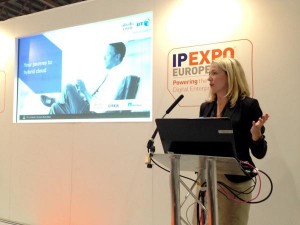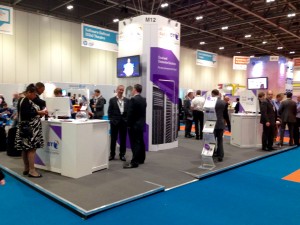
As one of many shows displaced by the closure of Earl’s Court, this year’s IPExpo Europe took the bold move to ExCel, alongside new, parallel events Data Centre Expo and Cyber Security Expo. The right move? First impressions were slick, friendly and busy enough to make getting a seat in most of the theatres a real challenge.
 After the usual unwanted intimacy of various forms of public transport, and the fervent search for a strong coffee – there was only one destination for bushy tailed morning visitors: the keynote theatre to see Sir Tim Berners-Lee. That’s right, the inventor of the world-wide-web… the very man who, 25years ago, had a “vague but exciting idea” that made it possible for you to be online reading this blog post today. Needless to say there was a palpable sense of excitement in the packed theatre as Tim took the stage.
After the usual unwanted intimacy of various forms of public transport, and the fervent search for a strong coffee – there was only one destination for bushy tailed morning visitors: the keynote theatre to see Sir Tim Berners-Lee. That’s right, the inventor of the world-wide-web… the very man who, 25years ago, had a “vague but exciting idea” that made it possible for you to be online reading this blog post today. Needless to say there was a palpable sense of excitement in the packed theatre as Tim took the stage.
The two big take-aways from Mr Berners-Lee passionate, rapid-fire talk were:
Ownership of private data
The data we create about ourselves, from browsing products to tracking our health. The data collected and collated by the companies that use it for profit. “Don’t be afraid of your personal data. It is far, far more valuable to you than anyone else,” said Tim before urging us to retake ownership of our data.
He suggested that in future there will be systems in place that put us back in control of our personal data to use how we see fit. Could your data help you locate the perfect gift for a loved-one? Or predict when a product you use might increase in price? Could your personal data even become a currency you exchange for services or products?
That said, he made a point of saying that authorities such as healthcare should be allowed to access relevant private information; when it is vital to do so. Provided this is done with transparency and what he labelled as “true accountability”.
Net neutrality
The web was and still is a neutral platform. This was the fundamental reason that it spread, because “any point of central control would have limited it” and the web can be built upon by anyone in any way – which is why it’s such an exciting platform, in the truest sense of the word. “The internet doesn’t care what I do with it,” explained Tim, adding that a tiered internet could never be as successful.
In fact during the audience Q&A Tim was asked for his thoughts on the “dark side” of the web and what the future holds for the more nefarious uses of our beloved internet. His response… “When you look at the web, you look at humanity. It non-judgementally reflects everything – both good and bad – that we as a race represent.”
Once the keynote was over it was back to scouring the schedule for the most interesting sessions. Including a ‘Cisco, Big Data and the Internet of Everything’ session in the Business Theatre. The session kicked off by highlighting the fact that 90% of the world’s data was created in the last two years and that 50 billion(!) smart, connected objects will exist by 2020. Cisco’s own Paul Davies then delved into just how exciting that is for businesses and explored how best to technically manage the challenges of this growing opportunity.
Coffee #2 was swigged. A muffin was eyed up but proudly resisted.
 After (once again) battling for a good seat in another busy, buzzing theatre – it was time for Cisco’s Jo Lakin to introduce John Gillam of BT Global Services, talking about realising possibilities in the Hybrid Cloud.
After (once again) battling for a good seat in another busy, buzzing theatre – it was time for Cisco’s Jo Lakin to introduce John Gillam of BT Global Services, talking about realising possibilities in the Hybrid Cloud.
John spoke about the fact that IT budgets are no longer “just about keeping the lights on.” Instead they’re increasingly about innovation and responding to opportunities. He went on to explain that “the transition from legacy IT is key when it comes to hybrid cloud,” building on this with use cases of BT and Cisco’s cloud based solutions that respond to the needs of customers, “allowing them to make business decisions that focus on flexibility & agility.” You can read a fascinating blog on how BT used the cloud to help LOCOG manage unpredictable web traffic during the 2012 Olympic Games here. John finished with: “We’ve worked with Cisco to offer a one-stop-shop without removing the choice of multiple providers.”

In fact the collaboration didn’t end there; BT and Cisco had a shared stand – #M12 for any floor plan memorisers – which was located in the Data Centre Expo portion of the event. It was great to see so many new and familiar faces stop by for a chat and a demonstration or two.
Early in his keynote Tim Burners-Lee revealed that – despite being frequently asked to – he doesn’t like giving predictions because “the future is something we all build”. That feels like a fitting sentiment to end on and nothing short of an exciting call-to-arms for anyone with a place in their heart for our connected world.

